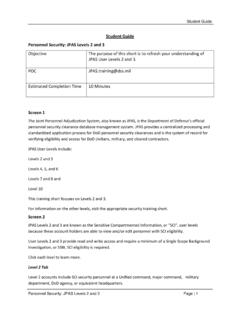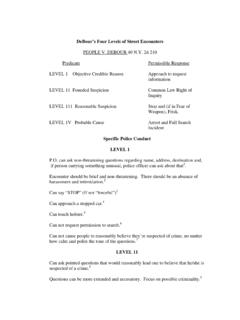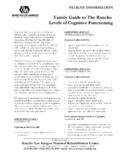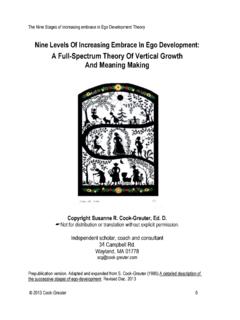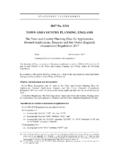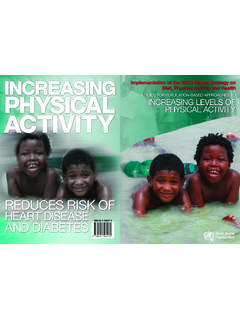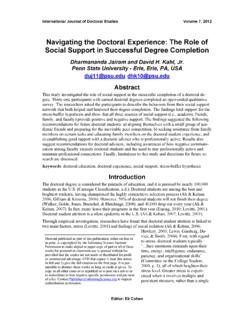Transcription of NATO STANDARD ATrainP-5 LANGUAGE …
1 NATO STANDARD ATrainP-5 LANGUAGE PROFICIENCY levels Edition A Version 1 DECEMBER 2014 NORTH ATLANTIC TREATY ORGANIZATION ALLIED TRAINING PUBLICATION Published by the NATO STANDARDIZATION OFFICE (NSO) NATO/OTAN INTENTIONALLY BLANK NORTH ATLANTIC TREATY ORGANIZATION (NATO) NATO STANDARDIZATION OFFICE (NSO) NATO LETTER OF PROMULGATION 11 December 2014 1. The enclosed Allied Training Publication ATrainP-5 , Edition A, Version 1, LANGUAGE PROFICIENCY levels which has been approved by the nations in the MCJSB, is promulgated herewith. The agreement of nations to use this publication is recorded in STANAG 6001. 2. ATrainP-5 , Edition A, Version 1, is effective upon receipt. 3. No part of this publication may be reproduced, stored in a retrieval system, used commercially, adapted, or transmitted in any form or by any means, electronic, mechanical, photo-copying, recording or otherwise, without the prior permission of the publisher.
2 With the exception of commercial sales, this does not apply to member nations and Partnership for Peace countries, or NATO commands and bodies. 4. This publication shall be handled in accordance with C-M(2002)60. Edvardas MAZEIKIS Major General, L TUAF Director, NATO Standardization Office INTENTIONALLY BLANK ATrainP-5 I Edition A Version 1 RESERVED FOR NATIONAL LETTER OF PROMULGATION ATrainP-5 II Edition A Version 1 INTENTIONALLY BLANK ATrainP-5 III Edition A Version 1 RECORD OF RESERVATIONS CHAPTER RECORD OF RESERVATION BY NATIONS Note: The reservations listed on this page include only those that were recorded at time of promulgation and may not be complete. Refer to the NATO Standardization Document Database for the complete list of existing reservations.
3 ATrainP-5 IV Edition A Version 1 INTENTIONALLY BLANK ATrainP-5 V Edition A Version 1 RECORD OF SPECIFIC RESERVATIONS [nation] [detail of reservation] BEL Only levels 1, 2, 3 and 4 can be achieved in a proficiency test. The interpolated values as given at Annex B to this edition are not used for the certificates given by the Belgian testing centre. CAN This agreement should only be applied to those members of the Canadian Forces involved in NATO affairs. ITA Italy will not comply with para ) for appointments to international posts for which a level 5 would be required. Note: The reservations listed on this page include only those that were recorded at time of promulgation and may not be complete. Refer to the NATO Standardization Document Database for the complete list of existing reservations.
4 ATrainP-5 VI Edition A Version 1 INTENTIONALLY BLANK ATrainP-5 VII Edition A Version 1 TABLE OF CONTENTS CHAPTER 1 LANGUAGE PROFICIENCY levels .. 1-1 INTRODUCTION .. 1-1 DEFINITION .. 1-1 PROFICIENCY levels .. 1-1 LANGUAGE PROFICIENCY PROFILE .. 1-2 STANDARDISED LANGUAGE PROFILE .. 1-2 ANNEX A TABLE OF LANGUAGE PROFICIENCY levels .. A-1 LISTENING COMPREHENSION .. A-1 SPEAKING .. A-3 READING COMPREHENSION .. A-5 WRITING .. A-7 ANNEX B DESCRIPTIONS OF PLUS levels OF LANGUAGE PROFICIENCY .. B-1 LISTENING COMPREHENSION .. B-1 SPEAKING .. B-3 READING COMPREHENSION .. B-5 WRITING .. B-7 ATrainP-5 VIII Edition A Version 1 INTENTIONALLY BLANK ATrainP-5 1-1 Edition A Version 1 CHAPTER 1 LANGUAGE PROFICIENCY levels INTRODUCTION The aim of this STANDARD is to provide NATO forces with a table describing LANGUAGE proficiency levels .
5 Participating nations adopt the appended table of LANGUAGE proficiency levels for the purpose of: a) Communicating LANGUAGE requirements for international staff appointments. b) Recording and reporting, in international correspondence, measures of LANGUAGE proficiency. c) Comparing national standards through a standardized table while preserving each nation s right to maintain its own internal proficiency standards. The descriptions at Annex A give detailed definitions of the proficiency levels of the common-recognised LANGUAGE proficiency skills: listening , speaking , reading , and writing . DEFINITION LANGUAGE proficiency/ comp tence linguistique An individual s unrehearsed, general LANGUAGE communication ability. [NATO agreed] PROFICIENCY levels The LANGUAGE proficiency skills described in Annex A are broken down into six levels coded 0 through 5.
6 In general terms, skills may be defined as follows: Level 0 - No proficiency Level 1 - Survival Level 2 - Functional Level 3 - Professional Level 4 - Expert Level 5 - Highly-articulate native At Annex B, a series of plus (+) descriptions is provided. A plus indicator may be added to a base level for training, evaluation, recording, or reporting purposes, to indicate a level of proficiency that substantially exceeds a 0 through 4 base skill level, but does not fully or consistently meet all of the criteria for the next higher base level. ATrainP-5 1-2 Edition A Version 1 LANGUAGE PROFICIENCY PROFILE LANGUAGE proficiency profiles will be recorded using a sequence of 4 digits, with plus (+) indicators if/when applicable, to represent the four LANGUAGE skill areas, and those skills will be listed in the following sequence: Skill L (CP in French) Listening Skill S (EO in French) Speaking Skill R (CE in French) Reading Skill W (EE in French) Writing STANDARDISED LANGUAGE PROFILE The four-digit number will be preceded by the code letters SLP (PLS in French) to indicate that the profile shown is the Standardized (S) LANGUAGE (L) Profile (P).
7 (For example: SLP 3321 means level 3 in listening, level 3 in speaking, level 2 in reading and level 1 in writing.) ANNEX A TO ATrainP-5 A-1 Edition A Version 1 ANNEX A TABLE OF LANGUAGE PROFICIENCY levels LISTENING COMPREHENSION Level 0 - No proficiency No practical understanding of the spoken LANGUAGE . Understanding is limited to occasional isolated words. No ability to comprehend communication. Level 1 - Survival Can understand common familiar phrases and short simple sentences about everyday needs related to personal and survival areas such as minimum courtesy, travel and workplace requirements when the communication situation is clear and supported by context. Can understand concrete utterances, simple questions and answers, and very simple conversations. Topics include basic needs such as meals, lodging, transportation, time, simple directions and instructions.
8 Even native speakers used to speaking with non-natives must speak slowly and repeat and reword frequently. There are many misunderstandings of both the main idea and supporting facts. Can only understand spoken LANGUAGE from the media or among native speakers if content is unambiguous and predictable. Level 2 - Functional Sufficient comprehension to understand conversations on everyday social and routine job-related topics. Can reliably understand face-to-face speech in a STANDARD dialect, delivered at a normal rate, with some repetition and rewording, by a native speaker not used to speaking with non-natives. Can understand a wide variety of concrete topics, such as personal and family news, public matters of personal and general interest, and routine work matters presented through descriptions of persons, places and things; and narration about current, past and future events.
9 Shows ability to follow essential points of discussion or speech on topics in his/her special professional field. May not recognise different stylistic levels , but recognises cohesive devices and organising signals for more complex speech. Can follow discourse at the paragraph level even when there is considerable factual detail. Only occasionally understands words and phrases of statements made in unfavorable conditions (for example, through loudspeakers outdoors or in a highly emotional situation). Can usually only comprehend the general meaning of spoken LANGUAGE from the media or among native speakers in situations requiring understanding of specialised or sophisticated LANGUAGE . Understands factual content. Able to understand facts but not subtleties of LANGUAGE surrounding the facts. ANNEX A TO ATrainP-5 A-2 Edition A Version 1 Level 3 - Professional Able to understand most formal and informal speech on practical, social, and professional topics, including particular interests and special fields of competence.
10 Demonstrates, through spoken interaction, the ability to effectively understand face-to-face speech delivered with normal speed and clarity in a STANDARD dialect. Demonstrates clear understanding of LANGUAGE used at interactive meetings, briefings, and other forms of extended discourse, including unfamiliar subjects and situations. Can follow accurately the essentials of conversations among educated native speakers, lectures on general subjects and special fields of competence, reasonably clear telephone calls, and media broadcasts. Can readily understand LANGUAGE that includes such functions as hypothesising, supporting opinion, stating and defending policy, argumentation, objections, and various types of elaboration. Demonstrates understanding of abstract concepts in discussion of complex topics (which may include economics, culture, science, technology) as well as his/her professional field.


